Contents
of the Spring 2012 Northants News
|
Sedums for the Rock Garden
Trevor
Wray
|
Many
species and selections of Sedum make excellent, long lived plants for the
garden. They are generally grown for both their foliage colour and attractive
flowers which are a magnet for bees and butterflies. They are best in a sunny
situation in a soil which is free draining and not too fertile, but generally
they tolerate some shade and everything except a water-logged soil.
| The
names of plants in garden centres are often confusing and sometimes actually
wrong. As a start the genus can be seen as Sedum,
Hylotelephium,
Telephium
and Petrosedum.
Then there will be the species and/or a cultivar name. These are often wrong;
visiting Cumbrian garden centres I saw three different plants labelled Sedum
'Coca-cola' varying in their vigour and leaf colour and the fairly new selection
'Angelina' seems to vary a fair bit. The alpine species seem to be a case of pot
luck at labelling time and sometimes even the picture label doesn't match the
plant.
Within
the group there are plants for the flower bed (or the herbaceous border if you
have that
sort of garden), and the rock garden. Some of the larger rock garden kinds are
suitable for the front of a border. A few should not be let loose in the garden
under any circumstances because of their vigour and propensity to spread by
broken stems, leaves and even seed. My attractive 'Angelina' is confined to a
pot but still tries to escape. I despair of ever clearing Sedum
album
from my peat garden. But don't let me put you off; it doesn't become a less
attractive plant because it has the wrong name and most growers lose the labels
quickly anyway.
|
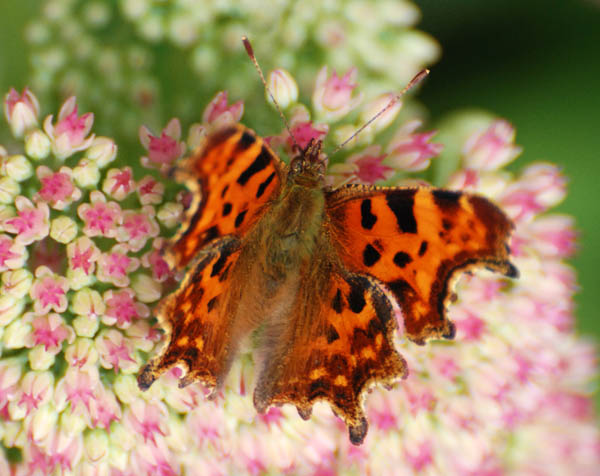 |
|
Sedum in the
garden are a magnet for butterflies and bees. |
Of
the kinds hardy in the garden some are herbaceous (annual stems dying back to a
rootstock) like Hylotelephium
and some evergreen. Here is a selection of my favourites.
|

|
Sedum
(or Hylotelephium)
'Autumn Joy': This old favourite, (it is an RHS Award of Garden Merit
plant), is an herbaceous cultivar which stands a couple of feet tall and
has large flat heads of small red flowers. Butterflies love it!
’Strawberries
and Cream’ (right) is another favourite here. There are many other large
growing Hylotelephium
types grown for coloured foliage. I like Sedum
'Chocolate', (guess what colour the foliage is), and 'Frosty Morn' with green
and yellowish-white foliage. Purists who like to grow species could try Sedum
ruprechtii
(left) which has white flowers and is another AGM plant.
|
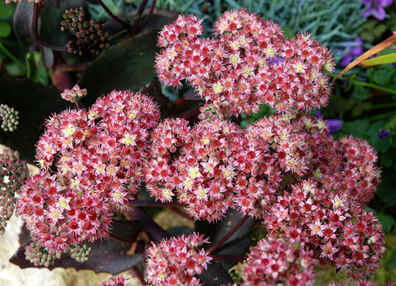
|
|
Sedum (or
Hylotelephium) ruprechtii |
Sedum (or
Hylotelephium) 'Raspberries and Ice' |
|
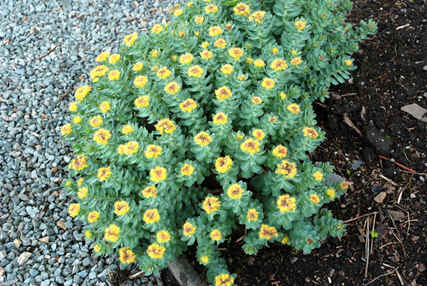
|
Sedum
roseum:
You should grow this because it is a British native, (from the very far north of
Scotland). From a nobly rootstock stems with glaucus leaves grow in spring to
produce greenish yellow flowers in early summer. A little bit weird, its
spreading habit is reminiscent of some Euphorbias. It has the sort of form that
should agree with succulent growers. As a Sedum, it has a claim to fame in that
it is impossible to grow from stem cuttings or leaves, (the wise men say).
However why would you even bother when it is so easy to break a few bits off
that knobbly root and pot them up?
|
|
Sedum (also
known as Hylotelephium and Petrosedum) roseum |
| Sedum
'Coca Cola':
As I mentioned there is some variation in the plants you get under this
name. Mine has silver grey leaves. However they are herbaceous plants with a
spreading habit, (rather than upright as in S.
spectabile.),
suitable for the front of a border or rock garden. In late summer there are
flower heads of pink, which again welcome butterflies. 'Coca Cola' is a hybrid
of S.
cauticola;
you noticed the similarity no doubt? S.
cauticola
is an alpine plant of much smaller habit but still herbaceous. It has selections
or hybrids named 'Lidakense', ‘Betram Anderson’ and ‘Vera Jameson’ which
are all worth growing. They can be spectacular grown over a rock
|
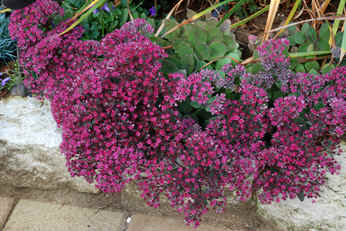
|
|
Sedum
‘Coca
Cola’ tumbles from the wall of a raised bed in my garden. |
Sedum
ewersi
(Hylotelephium
ewersii):
This is a true alpine with glaucus, green leaves and wiry glossy, brown
stems. Purplish-pink flowers are at the tips of the branches in August and
September. Branches tumble as far as three feet on mature specimens. It is a
hardy, deciduous perennial that is easy to grow.
The
following plants are all evergreen, (well not always green, but you know what I
mean), and what we would loosely term alpines.
|
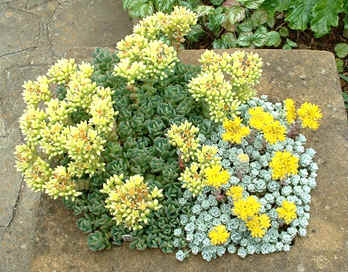
|
Sedum
spathulifolium:
This is mostly grown in the form 'Cape Blanco' which is covered in white farina
(powder) in summer. In winter the leaves are purple and look like the equally
attractive cultivar 'Purpurea'. This looks especially good with contrasting
yellow flowers low against the foliage. There is a green leaved version which is
not worth bothering with and a sickly yellow which is tricky to grow outside.
Sedum
oregonum:
To get the best from this stonecrop it must have a sunny and dry situation.
Bright green leaves in spring begin to turn brown, then an unbelievable red in
high summer. It has contrasting bright yellow flowers again.
Sedum
oregonense sounds
similar but has lime green leaves and cream flowers. Guess where these two come
from.
|
|
Two attractive stonecrops - Sedum
orogonense with
green leaves and Sedum
spathulifolium
‘Cape Blanco’ with white in Jeff’s garden.
|
| Sedum
dasyphyllum:
This is a very variable species in the wild mostly in forms with tiny glaucus
leaves in pastel shades. Think pale green, pink, lilac... In summer it can form
a delicate mat of great beauty. However a wet winter will decimate it and, as
you look at the slimy mess, you wonder why you bothered. Do not despair; a few
live leaves is all it needs. They quickly recover. My best plants are often self
set in dry sunny places.
|
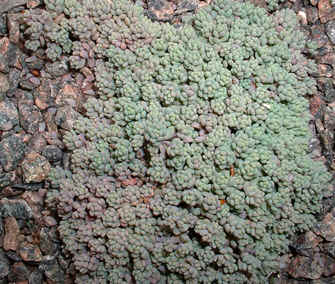
|
|
Sedum
dasyphyllum with
tiny leaves in pastel shades.
|
|
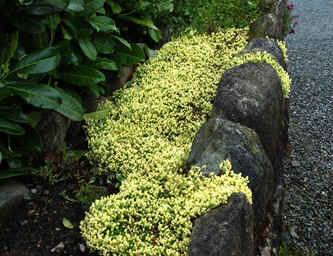
|
Sedum
acre:
I hesitate to recommend this aggressive, though diminutive, spreader. This is
the swathe of bright yellow that catches your eye in summer along the central
reservation of dual carriageways. Not in flower it is grass green the rest of
the year and spread by the passage of large vehicles no doubt. Every scrap is a
potential plant somewhere and don't even think of trying to hoe it to death in
your garden. (Ho, ho!) However, after the warning on the packet, there are some
more refined forms. Sedum
acre
'Aureum' has pale yellow foliage in the spring when it is most attractive. It
looks like its yellowness saps its vigour. By summer it is not so good and it
(or at least mine) is sparing with its flowers. S.
acre
'Elegans' is similar There is also a miniature form call 'Minuta' as you would
expect. I haven't let my 'Minuta' out of its pot just in case.
|
| Sedum
acre ‘Aureum’
contrasts with a black stone wall in the Lake District. |
|
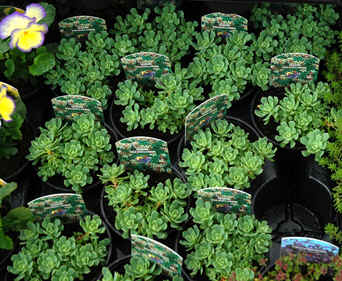
|
Sedum
pachyclados:
This is a fairly new introduction that is now mass produced for garden centres.
With its mat of light blue-green, almost silver, rosettes it is attractive but
it is a fairly active spreader, (by suckers, not the regular broken stems and
leaves). The ideal situation is jammed between rocks with any attempts to escape
being curbed. A few years ago I planted it in a trough and it is skirmishing
along a border with some vigorous silver saxifrages. I think the Sedum might
win. My first plant was overtaken by a spreading conifer which was an unfair
fight. I see on the internet that it has white flowers but I do not recall
seeing them on my plants.
I
hope I have whetted your appetite for these plants. They are definitely
‘succulents’ and they definitely have a place in your gardens. Since they
are so easy to propagate, if you want any of the above, just speak to me at a
meeting.
Trev
|
|
Sedum
pachyclados lined
up for sale at the Garden Centre.
|









